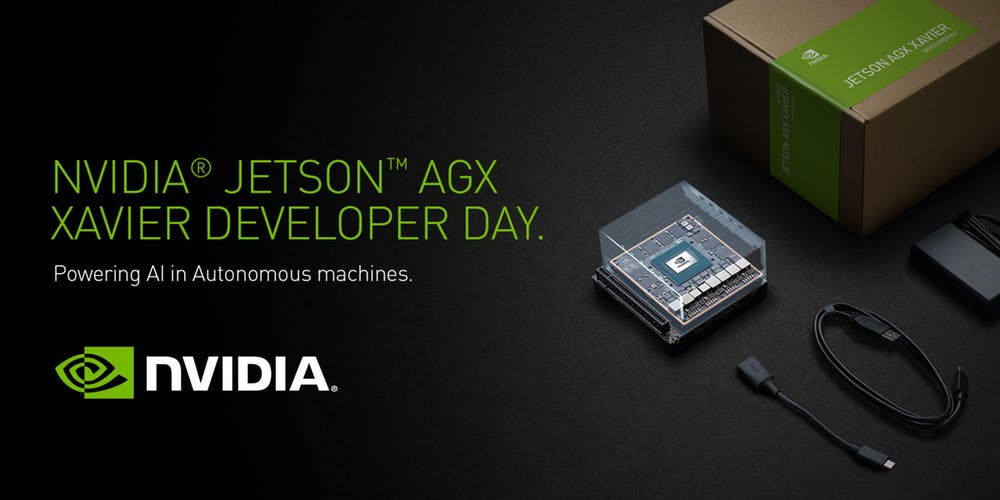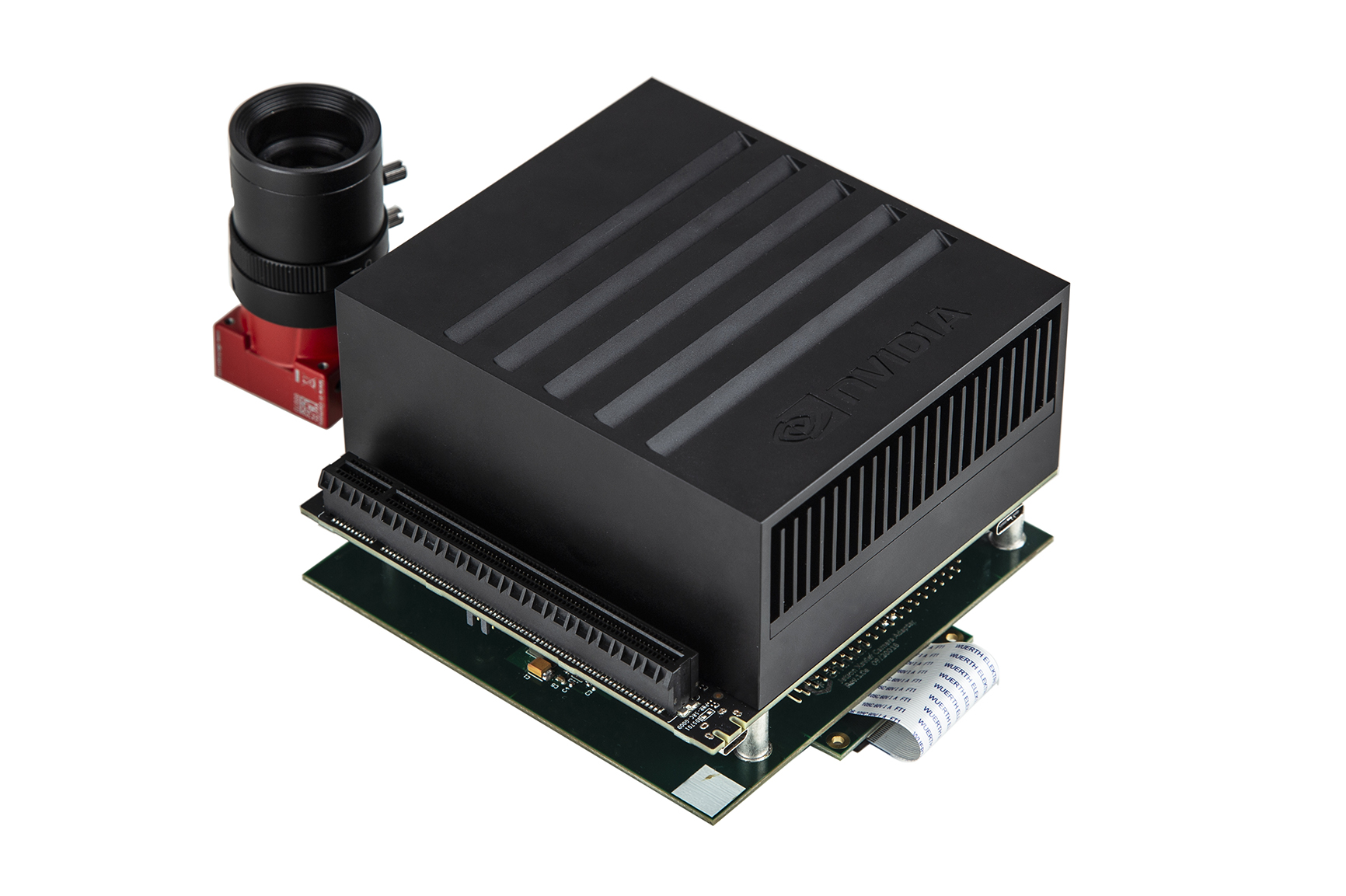Xavier: Enabling AI at the edge
An endorsed Jetson Ecosystem Partner of NVIDIA both in software and hardware services, Antmicro has worked with the Jetson embedded technology platform throughout all of its iterations, making use of the gradually increasing performance and latest improvements in the extremely successful deep learning paradigm to enable new edge AI applications.

The latest addition to the Jetson lineup is the Xavier AGX, providing a significant speed boost - to the point of putting it on par with PC-class solutions for Deep Learning workloads - thanks to the new Turing architecture and an increased number of both GPU and CPU cores, as well as additional specialized units such as the open source NVDLA (Deep Learning Accelerators). The platform faced a limited release recently, and Antmicro is one of the handful of companies to have worked with it at this early stage.
A special Xavier Developer Day was organized by NVIDIA to promote Xavier to a wider audience, co-located with their annual GTC EU event in Munich, and Antmicro was invited to speak about its experiences with and plans for Xavier. In a room packed with over 300 people selected by NVIDIA as potential Xavier early adopters, Antmicro’s VP Business Development, Michael Gielda, described some of the early cases where the Jetson Xavier is being applied in the company’s work.
Allied Vision collaboration
One of the key points of the presentation was a description of the collaboration with Allied Vision, a German camera maker with an internally-developed ISP - Alvium - which allows them to present a standardised camera interface to the users of their wide range of camera products.
 Coming from an industrial machine vision background, most of Allied Vision’s customers would expect very high quality and performance from their video solution which they’d normally connect to an industrial PC. This segment of the market has so far been slow to embrace the benefits of of the rapidly developing world of edge AI systems, which are primarily ARM and Linux-based, one of the reasons being a lower absolute performance, even despite a better power/performance ratio.
Coming from an industrial machine vision background, most of Allied Vision’s customers would expect very high quality and performance from their video solution which they’d normally connect to an industrial PC. This segment of the market has so far been slow to embrace the benefits of of the rapidly developing world of edge AI systems, which are primarily ARM and Linux-based, one of the reasons being a lower absolute performance, even despite a better power/performance ratio.
The vision offered by Jetson Xavier, as presented by NVIDIA during the Developer Day, namely all the benefits of an embedded solution with PC-like performance, therefore make it a very tempting proposition. The performance of Xavier in applications tested so far is living up to the expectations, and the embedded platform should be capable of replacing various PC-based systems with a more compact, robust and open-source friendly embedded solution.
For customers coming from the PC world, this still however means new interfaces, new data processing paradigms, open source OSs - an altogether unfamiliar territory. While the standardised Alvium camera interface helps alleviate some of the pain, how Antmicro comes into the picture is with providing its embedded expertise to build a camera driver stack that leverages the advantages of the Alvium platform on the one hand and corresponds to how the embedded Jetson platform works internally on the other, allowing maximum code reuse and transparency, badly needed in the complicated world of embedded cameras.
The work performed for Allied Vision targeted Jetson TX2 initially, but with the extra compute offered by the Xavier being a good match for the expectations of AV’s industrial clients, Antmicro and Allied Vision have extended their collaboration to also target the new platform, an effort that is currently under way and due to be demoed in shared demos at the Vision fair in Stuttgart - with a dedicated deep learning demo to match. Already at the Xavier Developer Day event, Michael showed off a hardware integration of a new Allied Vision camera and Antmicro’s camera extension board for the Xavier Developer Kit, prototyped at a rapid pace.
Boosting SkyWall300 and portable Edge AI devices
Another example of how the Jetson Xavier can be used to enable new use cases with its PC-like performance is the widely acclaimed SkyWall300 counter-drone solution, which uses a combination of deep learning methods to detect, track and identify the drone threats and a net-holding projectile to take them down. The system was successfully demonstrated at a dedicated counter-drone field test event in the UK earlier this year, and at a similar event in the US more recently, where it also proved effective against fixed-wing targets. SkyWall’s AI processing system is currently based on a PC+NVIDIA GPU system, but Antmicro’s early research shows a Xavier can be used to provide similar results in a smaller and more rugged footprint, unlocking better integration capabilities and potential spin off products from the collaboration with OpenWorks Engineering in which the product is being developed.
The presentation also covered how Xavier could be used to embed even more intelligence into and provide more autonomy for existing TX1/TX2-based portable solutions - on the example of a medical scanner developed by Antmicro for a Singapore customer which was discussed in detail in a joint talk with the customer at the 2017 edition of GTC EU.
Overall, the product fills an important role in NVIDIA’s edge AI lineup, allowing high-end products for most demanding AI and robotics tasks while the TX1 and TX2 continue to power less demanding applications. The Developer Day event, with a dedicated track and a packed agenda, was a good format, taking advantage of the excitement surrounding the new platform and bringing together many people facing similar problems and sharing insights.
Even if you did not have a chance to participate in the event or get your hands on a Xavier devkit, but you think Xavier or any other Jetson platform is a good fit for your new or existing product, don’t hesitate to let us know at contact@antmicro.com - we can help you build your hardware prototype, associated software and embed your AI application to take full advantage of the Jetson capabilities.
If you’re interested in our edge AI work and would like to keep up with the latest platforms we’re developing for, follow us on twitter for more details.